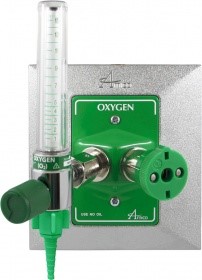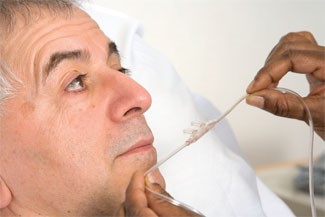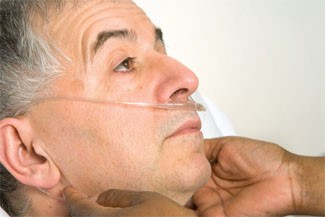Taking care of the client receiving Oxygen
Oxygen sources:
1. Wall outlet

2. Oxygen tank

3. Concentrator

4. Oxygen cannula/prongs

5. Oxygen mask

Oxygen Therapy Safety Precautions
- Place cautionary signs reading “No Smoking: Oxygen in Use” on the client’s door, at the foot or head of the bed, and on the oxygen equipment.
- Handle and store oxygen cylinders with caution, and strap them securely in wheeled transport devices or stands to prevent possible falls and outlet breakages. Place them away from traffic areas and heaters.
- Instruct the client and visitors about the hazard of smoking with oxygen in use. Teach family members and roommates to smoke only outside or in provided smoking rooms away from the client.
- Make sure that electric devices (e.g., razors, hearing aids, radios, televisions, and heating pads) are in good working order to prevent the occurrence of short-circuit sparks.
- Avoid materials that generate static electricity, such as woolen blankets and synthetic fabrics. Advise clients and caregivers to wear cotton fabrics and use cotton blanket.
- Avoid the use of volatile, flammable materials, such as oils, greases, alcohol, ether, and acetone (e.g., nail polish remover), near clients receiving oxygen.
Assisting with nasal cannula.
- Hold nasal cannula in proper position with prongs curving downward.

Fig. 7: Properly position nasal cannula with prongs curving downward.
- Place cannula prongs into nares.

Fig. 8: Place cannula prongs into nares.
- Wrap tubing over and behind ears .

Fig. 9: Wrap tubing around ears.
- Adjust plastic slide under chin until cannula fits snugly.

Fig. 10: Adjust plastic slide under chin until cannula fits snugly.
- Place gauze at ear beneath tubing as necessary (Fig. 11).

Rationale: Proper placement in nares ensures accurate administration. Note: The cannula permits some freedom of movement and does not interfere with the client’s ability to eat or talk.
Fig. 11: Place gauze at ear to reduce irritation and promote comfort.
- If prongs dislodge from nares, replace promptly.
Rationale: To ensure correct oxygen delivery and prevent hypoxemia.
- Assess for proper functioning of equipment and observe client’s initial response to therapy.
ASSISTING WITH THE USE OF THE OXYGEN CONCENTRATOR
- Explain procedure to client.
- Wash hands.
- Assemble equipment.
- Clean air filter.
- Wash humidifying bottle, if used.
- Check the humidifying bottle to make sure it has an adequate amount of distilled water in it, and the bottle is screwed on tightly, if used.
- Attach the air tube, if not on, to the humidifying bottle or oxygen concentrator.
- Take and records the client’s pulse and respiratory rate.
- Turn on the switch to the oxygen concentrator.
- Check that air is bubbling through the humidifying bottle.
- Check that air is flowing through the nasal cannula.
- Ensure that flow meter is set to appropriate level as noted in the care plan. (REGULATION OF FLOW METER DONE BY AIDE UNDER SPECIAL CIRCUMSTANCES ONLY.)
- Assist the client in applying the nasal cannula.
- Take and records the client’s pulse and respiratory rate.
- Turn off the oxygen concentrator.
- Assist the client in removing the nasal cannula.
- Wash hands.
- Observe for difficulty breathing; rapid pulse and respirations; cold, clammy skin; blue or darkened lips, fingernails, eyelids; client unable to sit still; client does not respond when you call client’s name, has headaches; or complains of no energy.
ASSISTING WITH THE USE OF THE OXYGEN TANK AND LIQUID OXYGEN RESERVOIR
- Explain procedure to the client.
- Wash hands.
- Assemble equipment.
- Put on gloves, as necessary.
- Check oxygen tank or reservoir gauge to see if there is enough oxygen. Call supplier if not.
- Wash humidifying bottle.
- Check the humidifying bottle to make sure it has an adequate amount of distilled water in it, and the bottle is screwed on tightly.
- Take and record the client’s pulse and respiratory rate.
- Turn on the oxygen tank.
- Ensure that flow meter is set to appropriate level as noted in the care plan. (REGULATION OF FLOW METER DONE BY AIDE UNDER SPECIAL CIRCUMSTANCES ONLY.)
- Check that water in humidifying bottle is bubbling.
- Check that air is flowing from the mask or nasal cannula.
- Assist the client in applying mask or nasal cannula.
- Cannula: prongs go into nose.
- Mask: should fit close to face, but not pinch it.
- Take and record the client’s pulse and respiratory rate.
- Turn oxygen tank off
- Turn the flow meter off.
- Assist the client in removing the oxygen mask or nasal cannula.
- Wash hands.
- Observe for difficulty breathing; rapid pulse and respirations; cold, clammy skin; blue or darkened lips, fingernails, eyelids; client unable to sit still, client does not respond when you call his/her name; has headaches; or complains of no energy.
- Record the use of the oxygen tank or liquid oxygen reservoir and observations of the client.
- Report to supervisor IMMEDIATELY if client has difficulty breathing; has rapid pulse and respirations; has cold, clammy skin; has blue or darkened lips, fingernails, and eyelids; is unable to sit still; does not respond when you call his/her name; has headaches; complains of no energy